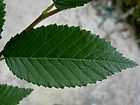Ulmus pumila 'Turkestan'
| Ulmus pumila | |
|---|---|
|
'Turkestan', RBG Edinburgh, planted 1902 | |
| Cultivar | 'Turkestan' |
| Origin | Germany |
Ulmus pumila L. 'Turkestan', sometimes known simply as the Turkestan Elm, was raised by Georg Dieck at the National Arboretum, Zöschen, Germany, from seed collected for him circa 1890 in the Ili valley, Turkestan (then a region of Russia, now part of Kazakhstan) by the lawyer and amateur naturalist Vladislav E. Niedzwiecki while in exile there.[1][2]
Taxonomy
'Turkestan' was originally named U. turkestanica circa 1880 by Regel,[3] and a few years later U. pinnato-ramosa by Dieck at Zöschen. In 1908 Litvinov treated the tree as a variety, Ulmus pumila var. arborea [4] but this taxon was ultimately rejected by Green, who sank the tree as a cultivar: "in modern terms, it does not warrant recognition at this rank but is a variant of U. pumila maintained and known only in cultivation, and therefore best treated as a cultivar".[5]
Description

'Turkestan' grows very vigorously, and can ultimately make a large tree,[6] however it also has a straggling, untidy habit, producing long shoots 0.60–0.95 m in length. [3] The tree is distinguished from U. pumila by its greater height and more slender leaves.[7][8] The leaves, which have pinnate venation, are 4–7 cm in length, ovate-lanceolate, with double-toothed margins, and finely pointed.
Pests and diseases
'Turkestan' has not been scientifically tested for resistance to Dutch elm disease, however several old specimens have survived unscathed by the disease (see Notable trees).
Cultivation
Dieck gave several specimens to the Späth nursery, which exported the tree across Europe, and to the USA. Some of these trees still survive, notably in the UK, and North America. Introduced to Croatia from Italy, 'Turkestan' can now be found in many places along the Croatian littoral.[9] Also introduced to Australia, the tree was listed by nurseries there (as U. turkestanica) in the early 20th century, but it is not known whether it still survives.
The tree was included in the early stages of the Dutch elm breeding programme, but was dropped owing to the susceptibility of its flowers, which emerge in early February, to frost. [10]
Notable trees
A specimen at the Royal Botanic Garden Edinburgh labelled Ulmus pinnato-ramosa, obtained from Späth in 1902, still survives (2015),[11][12] measuring 15 m height × 82 cm d.b.h. in 2004; another grows at Mote Park in Kent (20 m × 80 cm in 2009).[13] In the USA, a probable 'Turkestan' grows in the grounds of the Gillett-Beer Farm, Chicago Road, Warren, a suburb within the Detroit Metropolitan Area; the tree was 45 m tall, with a d.b.h. of 155 cm in 2012.
Accessions
- North America
- Arnold Arboretum. Acc. nos. 925-83, 698-87.
- Holden Arboretum. Acc. no. 60-317
- New York Botanical Garden. Acc. no. 1032/60
- Europe
- Brighton & Hove City Council, National Elm Collection . Full accession details unknown.
- Darmstadt University of Technology Botanic Garden, Darmstadt, Germany. Some accession details available
- Hergest Croft Gardens , Kington, Herefordshire, UK. One tree, as U. pinnato-ramosa; no accession details available.
- Royal Botanic Garden Edinburgh, as U. pinnato-ramosa. Acc. nos. 19021007, 20021586
- Sir Harold Hillier Gardens, UK. Acc. no. 1977.4795, (as U. pinnata-ramosa).
- Späth-Arboretum, Berlin. Acc. no 02-009.
- Strona Arboretum , University of Life Sciences, Warsaw, Poland
- University of Copenhagen Botanic Garden. No details available.
- University of Ulm Botanic Garden, Ulm, Germany. Some accession details available
References
- ↑ Dieck, G. (1894). Neuheiten-Offerten des National-Arboretums zu Zöschen bei Merseburg, 1894/95.
- ↑ Hansen, N. How to produce that $1000 premium apple, in Minnesota State Hort. Soc. (1900). Trees, fruits & flowers of Minnesota. Vol. 28. 470-1. Forgotten Books, London, 2013. ISBN 9781153197953
- ↑ 3.0 3.1 Elwes, H. J. & Henry, A. (1913). The Trees of Great Britain & Ireland. Vol. VII. 1848–1929. Republished 2014 Cambridge University Press, ISBN 9781108069380
- ↑ U. pumila L. var. arborea Litwinow, in Sched. Herb. Fl. Ross. No. 1992, &: 460 (1908)
- ↑ Green, P. S. (1964). Registration of cultivar names in Ulmus. Arnoldia, Vol. 24. Arnold Arboretum, Harvard University.
- ↑ J., White; D., More (2003). "Trees of Britain & Northern Europe". Cassell, London. ISBN 0-304-36192-5.
- ↑ A., Mitchell (1974). "A Field Guide to the Trees of Britain & Northern Europe". Collins, London. p. 254.
- ↑ Diagnostic photographs of Turkestan elms, their leaves and samarae, in the Björngårdsvägen, Södermalm, Stockholm, the Enkehusparken in Vasastan, Stockholm, and the Norra Kyrkogården in Solna, Sweden: www.tradgardsakademin.se
- ↑ Trinajstić, I. (2001). Turkestan elm - Ulmus pinnato-ramosa in 'The Dendroflora of Croatia', Šumarski list (:Journal of Forestry) 9-10, CXXV, 2001; 533-537.
- ↑ Went, J. (1954). The Dutch Elm Disease - Summary of fifteen years' hybridization and selection work (1937–1952). European Journal of Plant Pathology. 02(1954); 60(2): 109–1276.
- ↑ H. M., Heybroek; L, Goudzwaard; H., Kaljee (2009). Iep of olm, karakterboom van de Lage Landen (:Elm, a tree with character of the Low Countries). Centraal Boekhuis. p. 29. ISBN 978 9050112819.
- ↑ Photograph in spring of tree (on left) labelled on trunk Ulmus pinnato-ramosa, Royal Botanic Garden Edinburgh File:Royal-Botanical-Gardens-Edinburgh.jpg
- ↑ Johnson, O. (ed.). (2011). Champion Trees of Britain & Ireland. 300 pages. Royal Botanic Gardens, Kew, London. ISBN 978-1842464526